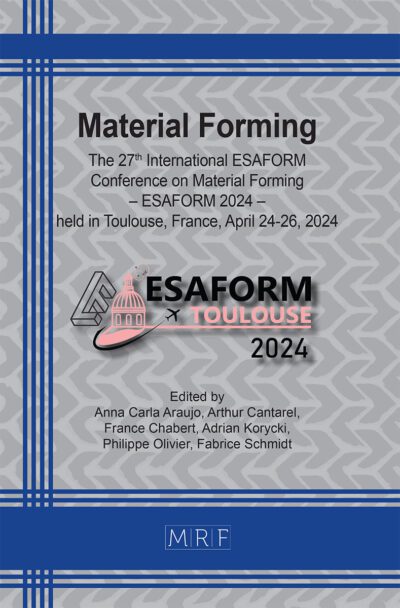A novel phase-field description for the anodic dissolution during electrochemical machining
Johanna Waimann, Annika Schmidt, Christian F. Niordson
Abstract. Electrochemical machining (ECM) exploits the effect of anodic dissolution to modify the surface roughness of a metal and the shape of the workpiece, allowing the machining of particularly hard metals without causing undesirable microstructural changes such as formation of dislocations [1]. The chemical reactions that take place are highly dependent on the local material properties. In our previous work [2], we presented a homogenized description based on the use of effective parameters. We described the processing of the metal using a dissolution level as an internal variable, assuming its evolution based on Faraday’s law of electrolysis. The dissolution process is enabled by the contact of the metal’s surface with the electrolyte and thus, considering the finite element simulation approach, only the finite elements located at the surface can dissolve. The contact between the metal and the electrolyte is ensured by introducing an activation function which is 1 if the respective finite element is located at the surface and 0 if it represents the bulk of the workpiece. To avoid numerical instabilities due to the Heaviside approach, we propose a phase-field ansatz to model the dissolution of the anodic material. The novel formulation allows a smooth transition between the dissolving surface regions and the bulk material. To demonstrate the ability of our model to predict the complex machining process, we will show some first numerical results.
Keywords
Electrochemical Machining, Phase-Field Approach, Process Simulation
Published online 5/7/2025, 7 pages
Copyright © 2025 by the author(s)
Published under license by Materials Research Forum LLC., Millersville PA, USA
Citation: Johanna Waimann, Annika Schmidt, Christian F. Niordson, A novel phase-field description for the anodic dissolution during electrochemical machining, Materials Research Proceedings, Vol. 54, pp 2203-2209, 2025
DOI: https://doi.org/10.21741/9781644903599-237
The article was published as article 237 of the book Material Forming
![]() Content from this work may be used under the terms of the Creative Commons Attribution 3.0 license. Any further distribution of this work must maintain attribution to the author(s) and the title of the work, journal citation and DOI.
Content from this work may be used under the terms of the Creative Commons Attribution 3.0 license. Any further distribution of this work must maintain attribution to the author(s) and the title of the work, journal citation and DOI.
References
[1] Klocke F.; Klink A.; Veselovac D.; Aspinwall D. K.; Soo S. L.; Schmidt M.; Schilp J.; Levy G.; Kruth J.-P.; Turbomachinery component manufacture by application of electrochemical, electro-physical and photonic processes. CIRP Annals, Vol. 63 (2), pp. 703-726, 2014. https://doi.org/10.1016/j.cirp.2014.05.004
[2] van der Velden, T; Rommes, B; Klink, A; Reese, S; Waimann, J; A novel approach for the efficient modeling of material dissolution in electrochemical machining. International Journal of Solids and Structures, Vol. 29, 111106, 2021. https://doi.org/10.1016/j.ijsolstr.2021.111106
[3] Xu, Z; Wang, Y.; Electrochemical machining of complex components of aero-engines: Developments, trends, and technological advances. Chinese Journal of Aeronautics, Vol. 34(2), pp. 28 – 53, 2021. https://doi.org/10.1016/j.cja.2019.09.016
[4] Klocke, F; Zeis, M; Klink, A; Technological and economical capabilities and manufacturing titanium- and nickel-based alloys via Electrochemical Machining (ECM). Key Engineering Materials, Vol. 504 – 506, p. 1237 – 1242, 2012. https://doi.org/10.4028/www.scientific.net/KEM.504-506.1237
[5] van der Velden, T; Ritzert, S; Reese, S; Waimann, J; A novel numerical strategy for modeling the boundary value problem of electrochemical machining. International Journal for Numerical Methods in Engineering, Vo. 124(8) 1856 – 1882. https://doi.org/10.1002/nme.7190
[6] Guyer, J. E.; Boettinger, J. W.; Warren, J. A.; Phase field modeling of electrochemistry. I. Equilibrum. Physical Review, Vol. 69, 021603, 2004. https://doi.org/10.1103/PhysRevE.69.021604
[7] Lin, C.; Ruan, H.; Shi, S.-Q.; Phase-field study of mechanico-electrochemical corrosion. Electrochimica Acta, Vol. 310, pp. 240 – 255, 2019. https://doi.org/10.1016/j.electacta.2019.04.076
[8] Taylor, R; Govindjee, S; FEAP – A Finite Element Analysis Program, User Manual, University of California at Berkeley, 2020. [9] van der Velden, T; Rommes, B; Klink, A; Reese, S; Waimann, J; Efficient modeling of material dissolution in electrochemical machining. Proceedings in Applied Mathematics & Mechanics, Vol. 21(1), 2021. https://doi.org/10.1002/pamm.202100042












